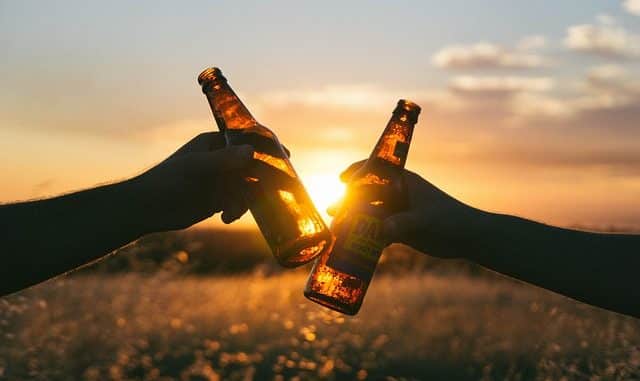
From the beginning of training for athletic performance, alcohol has been considered as one of the “deadly sins.” This is up there with having a poor diet or having sex before competition. All of these actions have been warned against for their ability to reduce performance in competition. This is particularly true in CrossFit competitions, where a range of abilities are tested.
For athletes, this can make the difference between a win or a loss. But, there has also been a few benefits associated with alcohol intake, like decreased stress. So, does taking in alcohol around a workout make a difference to your training or performance?
Alcohol, Training & Competition
In a lot of cases, many of the theories started by coaches or athletes regarding training, diet, and performance can be had to back up. This is because sports science is a relatively new field with studies still only emerging.
Fortunately, there are a few studies looking at the effects of alcohol consumption on training outcomes and fitness. So, regardless of the type of athlete you are, there is a good amount of research looking at how alcohol might affect you.
Below, we review these effects for different fitness qualities and make recommendations for how much you should take. Because CrossFit requires such a wide range of capabilities, we’ll look at all the major fitness qualities.
Endurance
Endurance is important for activities like running and rowing in CrossFit. Alcohol was thought to negatively impact endurance activities through increasing dehydration and decreasing nutrients availability.
This has largely been confirmed by a few studies. One study showed an immediate decrease in work capacity after taking in alcohol. Another showed a detrimental effect on recovery from training.
These effects are thought to be due to how alcohol affects glucose use, heart function, and the nervous system.
Strength & Muscle Mass
Another important fitness quality for CrossFit competition, or any sporting event, is strength. Here, alcohol has also shown to potentially impact both strength, muscle, and recovery after exercise negatively. However, the detrimental impact doesn’t seem to affect women.
Most noted is, women may be able to get away with a slightly less strict regime before competition than their male counterparts.
Power
This should come as no surprise after seeing the above results, but alcohol consumption can also negatively impact power. In fact, this is one of the reasons behind the decrease in work capacity seen in the above endurance study.
Skill
Because of the powerful impact alcohol can have on the brain and nervous system, it can also prevent skill learning or performance. This can affect movements like the clean or snatches, which are very technically demanding lifts. It may also slow down your progress in training.
The 5 Best Alcoholic Drinks For Training & Competition
The above results may look bleak. But, there are some studies showing alcohol to have no impact on training. The reason for this is that there is a threshold for which alcohol starts to impair performance.
This threshold is 20 mmol per liter of blood. For those unfamiliar with the more “sciencey” measurements, that’s the equivalent of roughly two-thirds of a pint of beer.
Also, alcohol has a dose-dependant effect on performance. This means drinking slightly over the threshold will only have a slight effect on performance.
Another issue to consider is the social life of an athlete. This can be an important part of their schedule, and, depending on their sponsors, might even be financially mandatory.
Alcohol can also provide some benefits through promoting relaxation. So, cutting alcohol altogether may be impractical and very difficult.
With this in mind, we put together a list of the best alcoholic drinks you can have. These choices are low-alcohol and low-calorie to provide you with the benefits of drinking while minimising the drawbacks.
1) White Wine (Pinot Grigio)
Per 100ml:
Alcohol volume: 8% – 13.5%
Calories: 75 kcals
0.1g Protein
3g Carbohydrate
0g Fat
2) Medium Dry Cider
Per 100ml:
Alcohol volume: 4.5% – 6%
Calories: 36 kcals
0t Protein
2.6g Carbohydrate
0g Fat
3) Vermouth (with diet soda)
Per 100ml:
Alcohol volume: 8% – 9%
Calories: 76 kcals
0.1g Protein
5.6g Carbohydrate
0g Fat
4) Shandy
Per 100ml:
Alcohol volume: 4.2%
Calories: 37 kcals
0.3g Protein
3.4g Carbohydrate
0g Fat
5) Champagne
Per 100ml:
Alcohol volume: 7% – 12.5%
Calories: 65 kcals
0.2g Protein
1g Carbohydrate
0g Fat
Wrap Up & Take Home Points
Alcohol can have a detrimental effect on both performances in competition and in training. But, alcohol can also have some benefits associated with increased relaxation and decreased stress.
It can also be difficult to remove alcohol from your routine completely. Fortunately, you can manage your alcohol consumption to enjoy its benefits and minimise its drawbacks. This is done by knowing which alcoholic drinks to avoid, and what to choose on a night out.
So, when training for your next CrossFit competition and heading out for your next social event, keep the following in mind:
- Try to keep to the low alcohol drinks listed above.
- Mixing spirits with diet soda and ice is a great way to decrease calorie and alcohol content.
- Sip your drink and keep alcohol consumption slow to reduce its accumulation in the body.
- Wherever possible, accompany alcohol consumption with food. Particularly, fat and protein, which can slow down digestion.


1 Trackback / Pingback
Comments are closed.